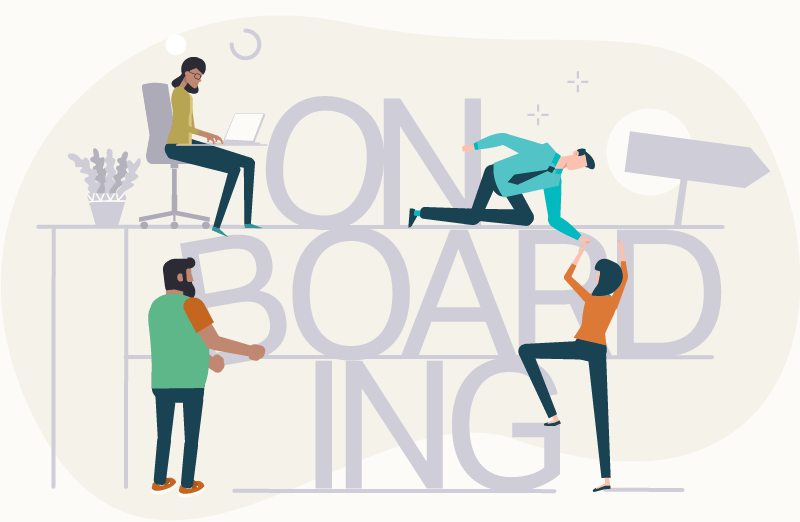Signs it's time to revamp your onboarding process

Retention issues are one of the biggest indicators that something is broken in your onboarding process. But if that’s the only red flag you focus on, it can be tricky to know exactly what needs fixing.
If you’re experiencing unusually high turnover among new and recent hires, you may be fairly certain your onboarding process has something to do with it. And you’re probably right. Retention issues are one of the biggest indicators that something is broken. But if that’s the only red flag you focus on, it can be tricky to know exactly what needs fixing. By peeling back the layers beyond high turnover, you’ll be able to spot specific issues and take intentional steps to fix them.
Your Organizational Culture Has Shifted
Year over year, culture becomes increasingly important for employees. So much so that Glassdoor has declared the 2020s the culture-first decade. We can bet this means organizations are going to be taking a long hard look at their cultures and making some changes. It’s critical your onboarding processes keep up with these shifts.
The Fix: Check for Alignment
If your organization has recently revisited their approach to culture, it may be time to revisit your orientation strategies as well. Make sure everything from your handbooks to the overall training experience is designed to immerse new employees in your current mission, vision and values. Use this time to help them understand why they were hired and where they fit within the big picture, so they’re ready to start contributing to the culture you’ve worked so hard to build from day one.
Every New Hire Gets the Same Training
When making hiring decisions, you consider each candidate’s unique skills, personality, background and interests. You hire individuals. You should be onboarding individuals, too. If you’re sending the same form email to every hire, pushing them through the exact same training modules and sending managers into meet and greets completely cold, you’re doing everyone a disservice.
The Fix: Make it Personal
Start by segmenting key components of your onboarding process based on employee seniority, department, job function, etc. There’s no need to waste a customer specialist’s time training them on contract protocol if they aren’t authorized to work with vendors. You can even use data you gathered through pre-hire assessments to shape some of this personalization. Some pre-hire assessments provide scaled-back results reports designed specifically for the candidate/employee. Share this with the employee. They will benefit from the information and appreciate your willingness to share their own test feedback.
Supervisors are Struggling to Connect
It can take a long time to understand how an individual prefers to receive feedback, what they expect out of their role and their goals for the future. So it should come as no surprise when managers struggle to know exactly how to connect with a new hire. This disconnect can lead to frustration for the manager and new hire alike.
The Fix: Give Them Insights
No matter how involved the supervisor was in selecting the final candidate, chances are they could still use a little help understanding who they’re working with. Put together a dossier breaking down important details about their new team member. Include their resume as a refresher, links to their LinkedIn and other relevant sites, and thoughtful details you learned throughout the hiring process. This is also another area where a pre-hire assessment may come in handy. Some include coaching reports that highlight thinking styles, interests, behavioral traits and even management tips, making it easier for managers to immediately engage new team members.
Inclusion Isn’t Part of the Strategy
Hiring a diverse workforce is only part of the D&I equation. You need to carry this commitment into your onboarding process. If you’re not. If your latest diversity and inclusion policy postdates the creation of your employee orientation program, it’s time to take another look.
The Fix: Communicate Inclusion from Day One
Share your organization’s commitment to inclusion with an onboarding session built specifically around D&I, add your policies to employee handbooks, and give them insight to the unofficial policies new hires often miss. You should also encourage and empower your current team members to be as welcoming as possible the moment the new hire walks through the door.
Promising Hires Start to Slip
Those first new days on a new job are exciting. New hires tend to dive into the promise and possibility of the position, ready to lend their talents and expertise. So what if your all-star new hire starts to falter after a few months? It’s possible your onboarding process just isn’t long enough.
The Fix: Don’t Stop Short
Most onboarding comes to an end within the first three months of a new hire’s tenure. This is problematic when you consider that it can take six months to a year before an employee feels they’re adding value to the team, so it may be beneficial to extend your onboarding beyond those first three months. In these later months, shift your focus to creating connections between the new hire and your existing team, help them set goals for 120/150/180 days out, and make sure their managers are available to answer questions and address any concerns they may have.
Even if you’re not losing people at an alarming rate, it could be beneficial to re-evaluate your onboarding process with some of these smaller red flags in mind. Only 12 percent of employees are actually satisfied with the onboarding they received. So it’s likely there’s some room for improvement in yours.

